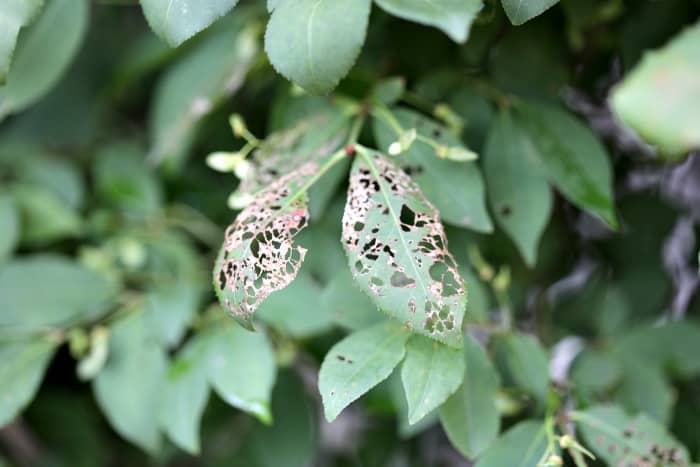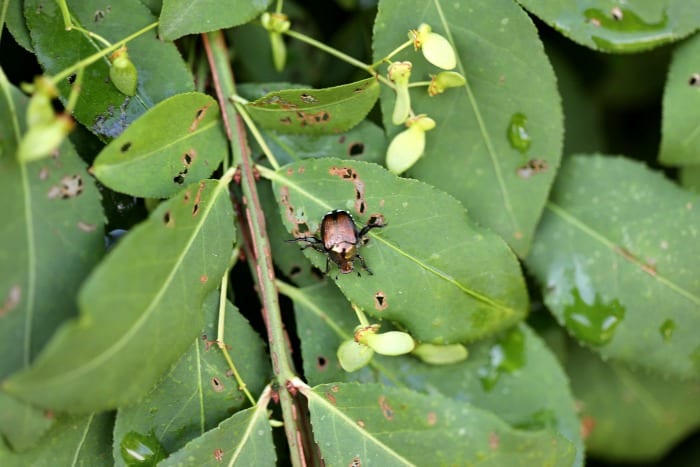Japanese Beetle control and prevention is crucial to protecting ornamental shrubs, flowers, vegetables, and fruit plants in the mid summer months.
What Are Japanese Beetles
Japanese Beetles are small beetles with a distinguishable green head. Originally from Japan, they were found in America in the early 1900’s. Since then they have developed a terrible reputation as a destructive, invasive species that are one of the worst pests you can have in your landscape.
As if these adult beetles weren’t bad enough, they have an equally destructive larvae stage. White grubs, are the larvae stage of the Japanese Beetle. For lawn enthusiasts, grubs can be a nightmare. They feed on the lawns root system, ultimately killing sections of your lawn. Large infestations can cause so much damage that the lawn can’t be rescued without a serious renovation.
Identify Japanese Beetle Damage
Japanese Beetles feed on the leaves, fruit, and flowers of hundreds of plant species. Their damage is easy to identify. Since they feed primarily on the soft tissue parts of the leaves you will see leaves that look like ‘skeletons’, meaning only the veins of the leaves are left. Check out this pic below of the damage left on this Burning Bush:

If ignored, damage can get so bad that it ultimately kills the plant. At the very least, infested ornamental plants are unsightly, and vegetable and fruit plants may not produce a viable crop.
Japanese Beetle Lifecycle
Japanese Beetles emerge from the soil in early summer and begin a constant cycle of feeding and mating over the next several weeks. After mating, the females go back into the soil for a couple of days to lay eggs. She’ll then emerge, feed on leaves and flowers, mate again, and go back to make another deposit of eggs into the soil. This cycle continues until she laid about 40-60 eggs total. Eventually, the adult beetles will die as temperatures begin to cool heading into fall.
The eggs that are laid in the soil hatch in mid summer. At this point the Japanese Beetle is in it’s immature larvae stage, known as a white grub. These grubs will feed heavily on your lawns roots so they get nice and fat before overwintering in your lawns soil. This is when your lawn can get severely damaged if you have a large infestation of grubs. To learn how to treat and prevent grub damage check out: White Grubs: Prevention and Treatment.
Organic Control and Prevention for Japanese Beetles
1. Manual Removal- Believe it or not, manually removing Japanese Beetles is the most effective way to control and prevent them from coming back. The method is simple… in early morning when beetles are most sluggish, simply pull them off foliage and collect them in small bucket of soapy water. The soapy water prevents them from flying out.
2. Azamax or Neem Oil- Both products contain the same active ingredient (Azadirachtin). The Azamax product is more concentrated, but Neem Oil is more accessible. Neem Oil can be found in most big box stores and garden centers. Both products are approved for organic use. It’s best to apply these products as a preventative (before beetles arrive), but can also be used shortly after the beetles are present.
3. Use Plants that Japanese Beetles Don’t Like- Catnip, garlic, chives, leeks, onions, marigold, tansy, and white geranium have all proven to repel Japanese Beetles. Using these plants in your garden and landscape will help protect surrounding plants.
Chemical Control and Prevention Options
1. Pyrethrin based insecticides such as Bonide Japanese Beetle Killer have proven to be effective in controlling Japanese Beetles. Pyrethrin is an organic compound derived from Chrysanthemums. It is safe to use on vegetables, fruits, herbs, and ornamental plants.
2. Dominion 2L (active ingredient Imidacloprid) is a great product for controlling Japanese Beetles. It can be applied to ornamental plantings as well as broadcasted over your turf. It is a systemic insecticide that works it’s way into the foliage and roots of the plant, poisoning insects that feed on it without harming your plants or turf.
3. Eliminate White Grubs! If you have Japanese Beetles there’s a good chance you also have grubs in your lawn. Grubs are the larvae stage of Japanese Beetles. Preventing white grubs can be a great way to reduce the Japanese Beetle population in your landscape. Check out everything you need to know about preventing and eliminating white grubs here: White Grubs: Prevention and Treatment
Japanese Beetle Control With Traps
There’s a lot of controversy surrounding the effectiveness of Japanese Beetle traps. Many gardeners argue that the attractants used in these traps actually lure in beetles from far away. They claim that while yes you will certainly trap a large number of beetles, it is likely they wouldn’t even be there to begin with if not for the traps.
But this claim isn’t entirely true. While it is true that Japanese Beetles are strong flyers that can travel several miles it is unlikely they will do so. As long as there is a nearby feeding source they will not go very far. In fact if your property has ornamental plants, flowers, or vegetables that beetles find desirable they will have no reason to leave.
However, if you live in a densely settled community with properties really close together, you could argue that Japanese Beetles are being lured to your traps from neighbors properties. That is why it’s best in these scenarios to team up with your neighbors so everyone in the properties surrounding each other have traps as well. The more property owners that participate the stronger the barrier will be and everyone will benefit.
Another caution when using Japanese Beetle traps is to make sure you place them in the correct spot! When traps are placed next to ornamental plants, flowers, or vegetables, the beetles will usually choose the plant over the trap. For traps to work, they need to be in a designated area of your yard, 30 feet away from plants or garden areas where beetles normally feed.
Check Out These Posts Next
White Grubs: Prevention and Treatment
Top Dressing Lawn: Benefits and Advice
Daylilies: Care, Maintenance, and Uses
Follow Me
Join my free email list!
Plus, follow me on Facebook, Instagram, and Pinterest.



This article is very informative! I do see skeleton leaves around my property more and more. Now I know the culprit. I’m going to try these tips you’ve provided here for sure. I think I’ll try the Neem oil first in my garden. But I am willing to upgrade to the stronger stuff if needed. The soap and water tactic seems helpful too. Thanks a lot of these tips! I’m on it! If I need more help…I’ll be back:)
My pleasure Jocelyn, let me know how it goes!